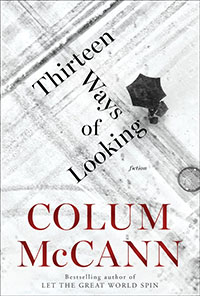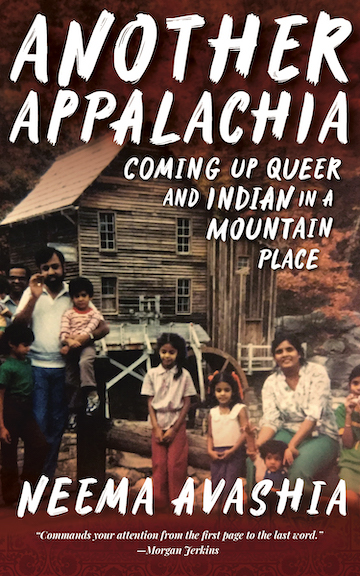Dangers Unforeseen
The stories in Colum McCann’s Thirteen Ways of Looking explore the inescapable nature of risk
If there’s a single theme running through the disparate stories that make up Colum McCann’s new collection, Thirteen Ways of Looking, it is the ineluctable nature of risk. Characters fall prey to unforeseen or unknowable threats, and their efforts to make the world safe and comprehensible fail. As the title suggests, McCann’s people spend a lot of time mulling over possibilities, considering life from many angles—sometimes literally—but all the looking and thinking seems to create even greater uncertainty.
 The title story, a novella, centers on the mysterious death of a retired New York judge named Mendelssohn, a man whose lively, puckish mind is trapped in a body gone frail with age. He’s a privileged fellow, a widower cared for in his Upper East Side apartment by a longtime maid for whom he feels a very old-fashioned, paternalistic affection—“She has a peculiar smell to her, a good smell, like furniture polish, dear Sally from Tobago, or is it Trinidad?” His thoughtless arrogance only slightly mars a fundamentally sweet, romantic nature. His mind is filled with loving memories of his wife, and even his anger—chiefly toward his egotistical son and the many annoyances of New York life—is tempered with humor.
The title story, a novella, centers on the mysterious death of a retired New York judge named Mendelssohn, a man whose lively, puckish mind is trapped in a body gone frail with age. He’s a privileged fellow, a widower cared for in his Upper East Side apartment by a longtime maid for whom he feels a very old-fashioned, paternalistic affection—“She has a peculiar smell to her, a good smell, like furniture polish, dear Sally from Tobago, or is it Trinidad?” His thoughtless arrogance only slightly mars a fundamentally sweet, romantic nature. His mind is filled with loving memories of his wife, and even his anger—chiefly toward his egotistical son and the many annoyances of New York life—is tempered with humor.
We meet Mendelssohn on the morning of what we soon learn will be his last day. The narrative chronicles his final hours by switching between his private thoughts and the dispassionate speculation of the nameless detectives who investigate his death. It zooms in and out in a way that is deliberately suggestive of a camera, and literal cameras are, in fact, central to the story. The detectives reconstruct nearly every moment of Mendelssohn’s day from video recorded in his home, on the street, and in the restaurant where he eats his last meal. “Thirteen Ways of Looking” is quite literally concerned with the act of looking, with the strange magic of perspective shift. But as with the Wallace Stevens poem it speaks back to, the story’s multitude of perspectives don’t dissolve mystery; they deepen it, uncovering the existential questions of Mendelssohn’s life even as they finally point toward the hard facts of his death.
The remaining three stories in the collection are much slighter creations, and of these the standout is “Sh’khol,” which won a Pushcart Prize. It depicts a mother’s frantic search for her son, who goes missing during their first Christmas in their new, post-divorce home on the west coast of Ireland. Rebecca is in her late forties, a relatively impoverished single parent—which would be challenge enough—but her job is made doubly difficult by her son’s disabilities. Thirteen-year-old Tomas, a neglected Russian orphan adopted at age seven by Rebecca and her ex-husband, was born deaf and suffers from Fetal Alcohol Syndrome. Although he can skillfully navigate video games, he cannot communicate with his mother or anyone else. Rebecca can only “tell a thing or two from the carry of his body, the shape of his shoulders, the hold of his mouth. Mostly she divined from his eyes.” Tomas sometimes lashes out violently, leaving Rebecca bloodied and bruised.
 The lonely, windswept coastal village is a refuge for Rebecca, who relishes the crashing of the sea and the harshness of the landscape, as well as the time alone with her son, whom she loves profoundly despite the unbridgeable gap between them. Her refuge crumbles when her Christmas gift to Tomas turns out to be a terrible mistake that leads to his disappearance. The story conveys the excruciating tension that envelopes Rebecca as she searches for Tomas, but it never lets the reader forget what it will mean for her to find him. She’s seeking to recover a very difficult love.
The lonely, windswept coastal village is a refuge for Rebecca, who relishes the crashing of the sea and the harshness of the landscape, as well as the time alone with her son, whom she loves profoundly despite the unbridgeable gap between them. Her refuge crumbles when her Christmas gift to Tomas turns out to be a terrible mistake that leads to his disappearance. The story conveys the excruciating tension that envelopes Rebecca as she searches for Tomas, but it never lets the reader forget what it will mean for her to find him. She’s seeking to recover a very difficult love.
“What Time Is It Now, Where You Are?” is a meditation on the creative process that also comments on the shifting experience of time and distance in the digital age. McCann invites us into the head of a writer struggling to pound out a New Year’s Eve short story on deadline. As the story takes shape, the characters—a young Marine in Afghanistan, her partner, and their child back home in the States—come slowly to life. The writer must answer a thousand questions about them to convey the simple action of a holiday phone call, and somehow the uncertainties of their fictional existence feed into the suspense and risk surrounding the call.
“Treaty” confronts an elderly nun with the unexpected reappearance of the man who tortured and raped her decades before. Although it seems the rawest, least carefully considered story in the collection, it may be the most powerful. The nun, Sister Beverly, has spent the intervening years pursuing her vocation with great passion, while continually fighting with herself to come to terms with her captor’s cruelty—“Hundreds of hours trying to get to the core of it, understand it, pick it apart.”
Beverly’s struggle to make sense of her victimization is one McCann knows well. In an author’s note at the end of the book, he writes about the vicious assault on a New Haven street that left him hospitalized in 2014, and he acknowledges that this collection has been shaped by that experience. Readers are directed to his Victim Impact Statement in the ensuing court case, in which he writes about the “punch behind the punch,” an enduring sense of danger and uncertainty that haunts victims and those who love them. The stories in Thirteen Ways of Looking all deliver something of that punch behind the punch. Their effect lingers.

Maria Browning is a fifth-generation Tennessean who grew up in Erin and Nashville. A graduate of Mount Holyoke College, she has attended the Clothesline School of Writing in Chicago, the Moss Workshop with Richard Bausch at the University of Memphis, and the Sewanee Writers’ Conference. She lives in White Bluff.


